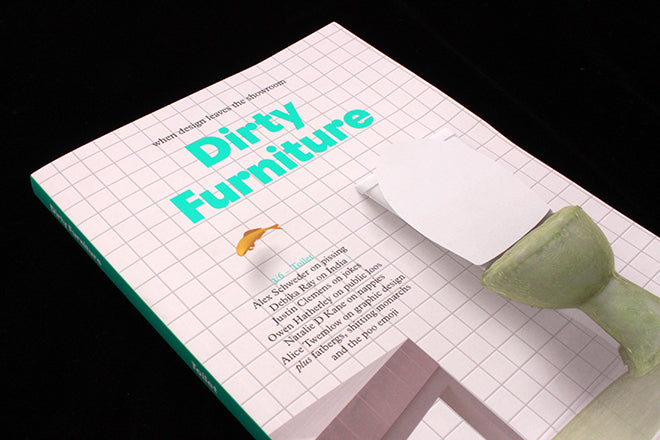
Dirty Furniture #3
Despite its affinity for mess, Dirty Furniture is one of the most organized, cleanly defined magazines that I know.
Launching after a Kickstarter campaign in 2014, the independent design title was conceived from the start as a series of six issues. It set out to take a different item of furniture for each one and use that as a springboard to explore a range of topics. The first issue was themed around the sofa, and the Kickstarter page promised that table, toilet, closet, telephone and bed would follow suit. Like Weapons of Reason, Dirty Furniture launched with a built-in expiration date in mind.
Usually after a mag starts, its vision evolves as publishers learn more about the trials and tribulations of independent publishing. Often, Kickstarter write-ups aim big and then reality hits and ambition has to dwindle (when a magazine says its going to be quarterly, this usually means they’ll be biannual or even annual). But Dirty Furniture confidently knew what it was going to do and how it was going to do it from the very start.
Now that they’ve hit the half-way mark and have released or flushed out its toilet themed issue three (above), the look, feel, and quality of the publication – it’s bold covers, its wise-cracking design details, and its critical and engaging in-depth articles – hasn’t changed a bit. Because of careful planning Dirty Furniture has delivered to the same high standard issue after issue.
To launch potty-mouthed number three, the title organized two exhibitions last week in London that showcased new work by design studio Takram as well as The Shit Museum’s latest collection. Inside the new issue, there’s an essay exploring the decline of the public toilet by architecture critic Owen Hatherley (above), academic Justin Clemens explores the psychology behind the unblockable hilarity of poo-bum jokes (also above) and Alice Tremlow explores the graphic design of toilet paper brands (below).
"The toilet issue seems to polarise between the graphic and the kitsch - I guess because that's how human beings handle the reality of shitting," co-founder and editor Elizabeth Glickfeld told us.
Smears and stains streaking the white pages (below) are a perfect example of Dirty Furniture’s fruity tongue-in-cheek approach to editorial design. Since its tagline is ‘when design leaves the showroom’, the layout is sleek but with purposeful slip-ups - a showroom gone wrong.
The title should be considered one of the leading examples of a new genre of design magazine that explore the narratives of humdrum, everyday objects - MacGuffin and Amuseum are two other magCulture favourites.
When a mag hits its issue three is usually the time that we determine whether it has ‘hit its stride’. With Dirty Furniture, it’s not that it’s hit its stride because it was in its stride from the very beginning. That’s why it’s our Magazine of the Week this week: it’s consistently good, filled with surprises but never straying from its essential and assured aesthetic.
"Because it inhabits the space between magazines and books - the content of each issue is not made obsolete by the one following my it - we always envisaged Dirty Furniture as a finite set," emphasise the editors. "We also wanted it to have a life long enough to allow us to fully explore the concept. We're happy with the number of issues we're doing because it also opens up the possibility of how, afterwards, we could apply the Dirty Furniture editorial approach to covering design to other formats and media."
By determining that there would only be six issues, Dirty Furniture gave itself a realistic target—and now every issue that they produce has got to be top-notch. It’s good to set realistic aims. We’ll miss it when it’s gone but for now, issue three is a perfect read for the loo and beyond.
Editors: Anna Bates, Elizabeth Glickfeld and Peter Maxwell
Art directors: Sara De Bondt and Mark El-khatib








